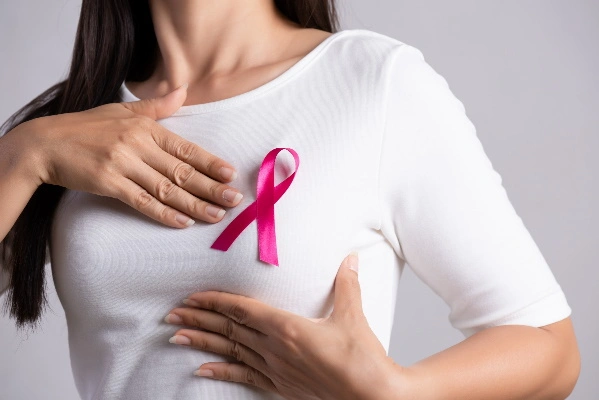BRCA gene

If you tested your DNA with a personal genomics service like 23andMe, AncestryDNA, FamilyTreeDNA, MyHeritage or another testing company, you can learn more about your risk factors for hundreds of diseases. By clicking the button above ⬆️, you can upload your raw DNA data file and receive a personalized 250-page health report with research links that is the most comprehensive.
BRCA stands for "BReast CAncer gene" and refers to two distinct genes, BRCA1 and BRCA2, which have been linked to an individual's likelihood of developing breast cancer.
Both the BRCA1 and BRCA2 genes are present in every human. Despite their names, these genes are not responsible for causing breast cancer. In reality, they play a crucial role in preventing breast cancer by aiding in the repair of DNA breaks that can result in cancer and the unregulated growth of tumors. As a result, the BRCA genes are referred to as tumor suppressor genes.
Although not all women with a BRCA1 or BRCA2 gene mutation will develop breast or ovarian cancer, possessing such a mutation elevates the likelihood of contracting these types of cancer.
Human genes known as BRCA1 and BRCA2 generate tumor suppressor proteins that aid in the repair of damaged DNA, thereby contributing to the maintenance of genetic stability within cells. If these genes undergo modifications that prevent the production or proper functioning of their protein products, DNA damage may not be adequately repaired. Consequently, cells may acquire further genetic changes that increase the risk of cancer.
The genes BRCA1 and BRCA2, also known as BReast CAncer gene 1 and BReast CAncer gene 2 respectively, are responsible for producing proteins that aid in the repair of damaged DNA. Each individual inherits one copy of these genes from each parent, resulting in two copies of each gene. These genes are commonly referred to as tumor suppressor genes, as the presence of harmful variants or mutations can lead to the development of cancer.
Individuals who possess detrimental mutations in any of these genes are at a heightened susceptibility to various cancers, particularly breast and ovarian cancer, as well as other types. Moreover, those who have inherited a deleterious mutation in BRCA1 and BRCA2 are prone to developing cancer at an earlier age compared to those without such a mutation.
Either parent can pass on a detrimental variation in BRCA1 or BRCA2. If a parent carries a mutation in either of these genes, each of their children has a 50% chance (or 1 in 2 chance) of inheriting the mutation. These mutations, also known as germline mutations or variants, are present in all cells of the body from birth.
Although an individual may have received a detrimental variant in either BRCA1 or BRCA2 from one parent, they would have also received a healthy copy of the gene from the other parent. This is due to the fact that in the majority of cases, embryos with harmful variants from both parents are unable to develop. However, the healthy copy of the gene may be lost or altered in certain cells within the body over the course of the individual's life. This type of alteration is referred to as somatic. Cells lacking functional BRCA1 or BRCA2 proteins can proliferate uncontrollably and lead to the development of cancer.
Although these statistics may be concerning, it is crucial to acknowledge that a BRCA mutation is present in less than 10% of women who receive a breast cancer diagnosis. Additionally, with prompt identification, the overwhelming majority of breast cancer instances can be effectively managed, even for those with a BRCA1 or BRCA2 mutation.
Follow the link of the selected polymorphism to read a brief description of how the selected polymorphism affects Cancer of the mammary gland and see a list of existing studies.
SNP polymorphisms related to the topic Cancer of the mammary gland:
About The Author
Li DaliLi Dali, a National Foundation for Outstanding Youth Fund recipient, is a researcher at the School of Life Sciences in East China Normal University. He earned his PhD in genetics from Hunan Normal University in 2007 and conducted collaborative research at Texas A&M University during his doctoral studies. Li Dali and his team have optimized and innovated gene editing technology, leading to the establishment of a world-class system for constructing gene editing disease models.


